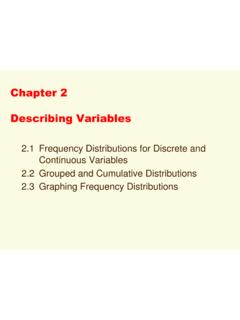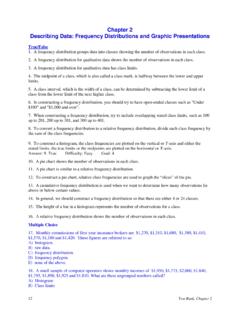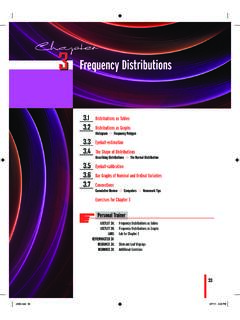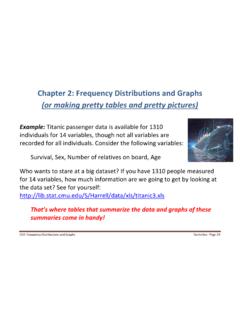Transcription of Chapter 2 - Frequency Distributions and Graphs
1 Page 7 Chapter 2 - Frequency Distributions and Graphs 1. Which of the following does not need to be done when constructing a Frequency distribution ? A) select the number of classes desired B) find the range C) make the class width an even number D) use classes that are mutually exclusive Ans: C Difficulty: Easy Section: 2. The lower class limit represents the smallest data value that can be included in the class. Ans: True Difficulty: Moderate Section: 3. When data are collected in original form, they are called _____.
2 Ans: raw data Difficulty: Easy Section: 4. The _____ of a specific class is the number of data values contained in it. Ans: Frequency Difficulty: Easy Section: 5. If a Frequency distribution had class boundaries of , what would be the class width? Ans: 15 Difficulty: Moderate Section: 6. For the class 5 - 20, the upper class limit is A) B) 5 C) 20 D) Ans: C Difficulty: Easy Section: 7. What are the boundaries of the class 11-17? A) and B) 8 and 20 C) 11 and 17 D) 6 Ans: A Difficulty: Easy Section: 8.
3 In an ungrouped Frequency distribution of the average age of high school graduates, what would be the boundaries for the class of graduates who were reported to be 18 years old? A) 17 19 years old C) years old B) years old D) years old Ans: B Difficulty: Easy Section: 9. What is the midpoint of the class 6-10 ? A) B) 8 C) 5 D) 4 Ans: B Difficulty: Easy Section: Full file at 2 - Frequency Distributions and Graphs Page 8 10. Greg wants to construct a Frequency distribution for the political affiliation of the employees at Owen's Hardware Store.
4 What type of distribution would be best? A) ungrouped B) grouped C) categorical D) cumulative Ans: C Difficulty: Easy Section: 11. What is the lower class limit of the class 13 17? A) 15 B) 17 C) 13 D) Ans: C Difficulty: Moderate Section: 12. What is the midpoint of the class 15 18 ? A) B) C) 3 D) 16 Ans: B Difficulty: Easy Section: 13. What is the upper class boundary of the class 23 35 ? A) 35 B) C) D) 7 Ans: C Difficulty: Moderate Section: 14.
5 If the limits for a class were 20 38, the boundaries would be Ans: True Difficulty: Easy Section: 15. For grouped Frequency Distributions , the _____ is obtained by adding the lower and upper limits and dividing by 2. Ans: class midpoint Difficulty: Easy Section: 16. What is the lower class limit in the class 9-13 ? A) 9 B) 11 C) D) Ans: A Difficulty: Moderate Section: 17. Which of the following pairs of class limits would be appropriate for grouping the numbers 9, 12, 7, and 14 ?
6 A) 6-10 and 10-14 C) 7-9 and 10-14 B) 7-9 and 12-14 D) 7-10 and 11-14 Ans: D Difficulty: Moderate Section: 18. Thirty students recorded the colors of their eyes, choosing from the colors brown, blue, green, hazel, and black. This data can be appropriately summarized in a(n)_____ . A) open-ended distribution C) grouped Frequency distribution B) categorical Frequency distribution D) upper boundary Ans: B Difficulty: Moderate Section: 19. What are the boundaries of the class ?
7 A) B) C) D) Ans: D Difficulty: Moderate Section: Full file at 2 - Frequency Distributions and Graphs Page 9 20. For the class , the width is Ans: False Difficulty: Easy Section: 21. When the range is large, and classes that are several units in width are needed, a _____ Frequency distribution is used. Ans: grouped Difficulty: Moderate Section: 22. The cumulative Frequency for a class is the sum of the frequencies of the classes less than and equal to the upper boundary of the specific class.
8 Ans: True Difficulty: Easy Section: 23. A recent statistics exam yielded the following 25 scores. Construct a grouped Frequency distribution with the class limits shown below. 61 83 77 58 65 53 86 61 65 96 81 83 46 73 81 76 90 73 98 57 76 74 49 82 99 Class Limits Tally Frequency 41-50 51-60 61-70 71-80 81-90 91-100 A) Class Limits Frequency 41-50 2 51-60 3 61-70 4 71-80 6 81-90 7 91-100 3 Full file at 2 - Frequency Distributions and Graphs Page 10 B) Class Limits Frequency 41-50 2 51-60 2 61-70 5 71-80 6 81-90 7 91-100 3 C) Class Limits Frequency 41-50 2 51-60 3 61-70 5 71-80 5 81-90 6 91-100 4 D)
9 Class Limits Frequency 41-50 3 51-60 2 61-70 4 71-80 7 81-90 6 91-100 3 Ans: A Difficulty: Easy Section: Full file at 2 - Frequency Distributions and Graphs Page 11 24. Construct a Frequency polygon from the following Frequency distribution . Temperature Frequency 1 3 6 10 8 7 Ans: Difficulty: Moderate Section: Full file at 2 - Frequency Distributions and Graphs Page 12 25. A recent statistics exam yielded the following 10 scores. Construct a Frequency polygon distribution using the class limits shown below.
10 80, 99, 77, 67, 93, 71, 76, 86, 79, 71 Class Limits Midpoints Tally Frequency 61-70 71-80 81-90 91-100 A) B) C) D) Ans: B Difficulty: Moderate Section: Full file at 2 - Frequency Distributions and Graphs Page 13 26. Find the class with the least number of data values. A) 55-65 B) 65-75 C) 75-85 D) 85-95 Ans: D Difficulty: Easy Section: 27. Find the class with the greatest number of data values. A) 55-65 B) 65-75 C) 75-85 D) 85-95 Ans: A Difficulty: Easy Section: 28.











